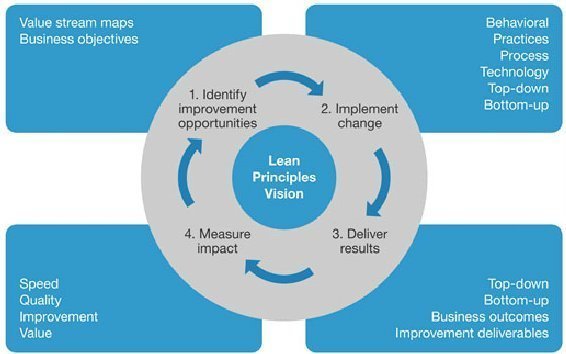Define a software delivery strategy for business innovation – four key steps
As software takes a central role in modern business models, application delivery capability has become the key enabler of disruption
As software takes a central role in modern business models, application delivery capability has become the key enabler of disruption.
Long-term planning and long application delivery cycles cannot provide the responsiveness needed to transform customer experience, embrace the mobile mind shift and leverage opportunities of cloud and big data. Seizing these opportunities requires modern application delivery capabilities.
Customers have never had more competition for their attention; brand loyalties quickly drown in the flood of attractive alternatives. In a world dominated by software, products are more dynamic, change is continuous and more frequent, and shorter delivery cycles have become commonplace.
The clock is ticking, and customers are determining its speed.
Blockbuster thought it had more time to work out its new business model, but by the time it started executing on it, it was too late. The race is on, and the fastest competitors will win.
Speed, yes, but with high quality
Customers tell us in most of our daily interactions that speed is the most important business driver, but expectations for quality are high – faster delivery is of little value if the quality is low.
Delivering better software faster means accelerating the performance of software delivery teams. There are some companies that can rip the sticking plaster off and discard their old waterfall ways, but not many.
So what's the best way to develop a strategy to improve delivery? There is no one prescribed recipe. Strategies depend on various factors, including leadership vision, cultural context, business domain, level of disruption and customer obsession and existing delivery capabilities.
But there are some key aspects successful application development and delivery leaders execute on, and various industry thought leaders agree to, on how lean and agile can successfully help transform businesses, address cultural change, lead with dynamism and courage, and to build-measure-learn.
From an operational perspective, enterprise application delivery teams' transformation strategies need to set a continuous improvement plan with these four steps:
Step 1: Identify improvement opportunities
Before initiating the journey, make sure everyone in the organisation knows and is internalising lean principles and values.
Usually 30% of the workforce in an organisation will be open to embrace change – use tactics to involve them, because they will become the change agents. In the Royal Philips global transformation, the CEO Frans Van Houten chose to empower his executives and management to enable change throughout the organisation.
To help identify improvement opportunities in a pragmatic way, enterprise application delivery teams could, for example, adopt a lean visual analysis approach to eliminate waste and focus on value.
A picture is worth a thousand words. Visually highlighting and exposing what barriers to faster delivery exist in a process reminds everyone of what needs to be fixed urgently.
An underused but very effective visual approach for this is value stream mapping (VSM). It's a customer-driven approach to identifying and resolving disconnects, redundancies and gaps in how work is carried in teams and across teams to deliver customer outcomes.
Step 2: Implement change
You now have a plan to remove the most important obstacles, but also a pragmatic practice for identifying obstacles that you can repeat and improve.
No transformation can happen before there is evident focus on change management. If change is not happening, you risk fixing issues and removing obstacles that will soon reappear because peoples' behaviour has not changed.
Include change activities in the improvement plans, including modernising mindset and behaviour. It's behaviour that produces results. Behavioural change has to happen throughout the entire organisation and, in most cases, leaders will need to drive by example.
You need to evolve people's mindset to one where learning and experimentation become part of their everyday job.
Step 3: Deliver results
A completed VSM will record for each process step: process time or touch time, which is the time it takes to complete the work; lead time or throughput, which is the elapsed time it takes for work to be completed from when it is available to when it is finished; and percent complete and accurate, which measures the quality of the work at that step. The target state VSMs will show the corresponding improvements in each of these metrics. Now it's time for the action.
More on cloud computing
- Computer Weekly buyer's guide to cloud computing
- Computer Weekly buyer's guide to cloud storage
- Computer Weekly buyer’s guide to hybrid cloud
- Taking the pulse of the cloud computing market
- CW buyer's guide to optimising networks for cloud computing and virtualisation
Step 4: Measure impact
Metrics can be the perfect tool to track what's working and what's not, both at the business concept or value stream level, and at the detailed transformation subsegment level.
However, metrics should be defined and used to focus and initiate the right conversations or analysis in the right areas that prove to be problematic, so that corrective actions can be taken. Focus some metrics to help understand if value is being delivered to the business and link that back to reprioritise the improvement efforts.
It’s the business that will drive the delivery strategy approach
The strategy for a transformation to continuous delivery will largely depend on the business context your enterprise will be living through the next 10 years. Understand what rate of change the business will need as it gets deeper into the age of the customer.
Additionally, a large and global corporation will have diverse rates of change by division or by country. In that case, the best strategy might be to adapt capabilities to the fastest-paced one.










